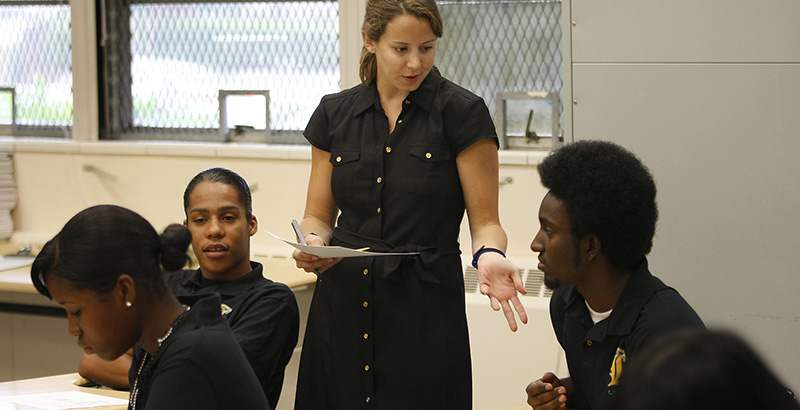Petruzzi: In Growth-vs.-Proficiency Debate, Data, Trust, and Time Are Keys to True Student Performance

For too long, student proficiency has been winning the debate against student growth. Somehow the reigning idea has been that we can understand student success along with educator and school effectiveness by measuring absolute student outcomes, absent their starting point and ignoring the progress and growth students have achieved.
Using math and reading test scores to determine school performance asks us to measure where students are at a single moment and then make decisions and determinations about those students, their teachers, and their school — all based on how proficient they are at that time. This calculus oversimplifies the reality of public education, the quality of a school, and students’ actual ability to succeed. And it’s frankly just lazy.
When proficiency is the only metric by which we seek to understand how well our schools are educating our kids, we miss out on other important considerations. For instance, if we were to measure a student’s performance based on his or her growth — the student’s progress in learning, and how quickly that learning advances over time — we’d get a better idea of how well the school is actually educating its students.
Consider students who live in historically under-resourced communities. They may have no choice but to attend a neighborhood school that receives less funding and less effective educators than the school in the more affluent community across town. And even before these students start kindergarten, they may already be behind, due to lack of access to books in their homes, for example.
Now, imagine that after eight years attending under-resourced elementary and middle schools, these students may be lagging in test scores relative to students in better-funded schools. Too often, we see students entering ninth grade reading at fifth-, fourth-, even third-grade levels. With such dramatically low proficiency, these students are likely to be left behind, drop out, fail to graduate, and be unprepared for the world after school.
But consider a student who happens to be behind but enters a high school with the right resources, highly effective teachers, and a clear mission to get students back on track. Her test scores improve dramatically, and she starts catching up. In four years, she learns better and faster than she did in the prior eight years of her education. By 11th grade, instead of being six grade levels behind in reading and math, she’s one level behind — and all that progress was accomplished at that high school.
She still isn’t scoring at proficiency levels for her grade. Does that mean her high school is failing her? Of course not.
This story isn’t hypothetical. At Green Dot’s Alain Leroy Locke College Preparatory Academy in Los Angeles, students regularly enter ninth grade far behind California’s expected proficiency levels. But once at Locke, students achieve the kind of growth that demonstrates the success of the school and of the students themselves. For instance, from 2013 to 2016, Locke students improved their reading levels by 300 Lexile points using the nationally normed Reading Inventory program, equivalent to approximately five to six years of growth in three years.
The success of those students, and all other students who achieve substantial growth in their learning, should be calculated and considered. Only by embracing a growth-focused system of metrics will our public education system focus on the individual’s success.
In fact, we’re now able to measure student growth against a normalized cohort of 1.7 million students from across the state. Thanks to a partnership with the education nonprofit CORE, in conjunction with the California Department of Education, we’re able to score schools and subgroups of students using their Student Growth Percentile. That figure represents how well schools have done at moving students from point A to point B on Common Core testing, relative to schools serving similar youth. If a school has a percentile of 50, students have achieved average growth.
At Green Dot, we chart student growth relative to expected performance to get a clearer picture of how students are actually progressing, even if they continue to perform below “meets standard” on state tests. We want to support them with truly personalized learning to close the gap, to make sure they are adding more than one year of learning for each year they’re with us.
We use entering level data to shape personalized academic interventions and meet students where they are, enabling educators to both celebrate successes and identify gaps to focus on for future growth.
For some, it could mean an intervention course alongside a grade-level course in algebra. For others, it might be cross-curricular content to foster growth in reading, researching, and writing through engagement in areas of relevance such as civil rights, scientific theory and phenomenon, or art methodologies, forms, and types.
Our classrooms are places that engender trust and, subsequently, academic risk through thoughtfully developed relationships between students and teachers who are effective, empowered, and highly resourced, and who can provide varied opportunities to individual students at different levels of understanding and engagement.
In fact, student growth data has been a powerful source of motivation for our teachers because they can see how their work positively impacts individual student learning over time. This system has worked well for our educators and students because we understand that our students need more than one assessment to demonstrate their success.
This is true even for students with the most extreme challenges. At Green Dot’s Ánimo Western Charter Middle School in Los Angeles, a campus that has faced generations of troubling outcomes and where students start significantly behind, the average Student Growth Percentile for English was 71 — far above the median of 50. Clearly, growth-oriented instruction can catch students up.
We need to go back to basics and recalibrate the foundational formula we use to measure student performance and school effectiveness. Moreover, we need to end this tired debate and finally embrace a broader understanding of public education in America — one that seeks to be the great equalizer our system was always meant to be.
Marco Petruzzi is the CEO of Green Dot Public Schools National.
Get stories like these delivered straight to your inbox. Sign up for The 74 Newsletter

;)
